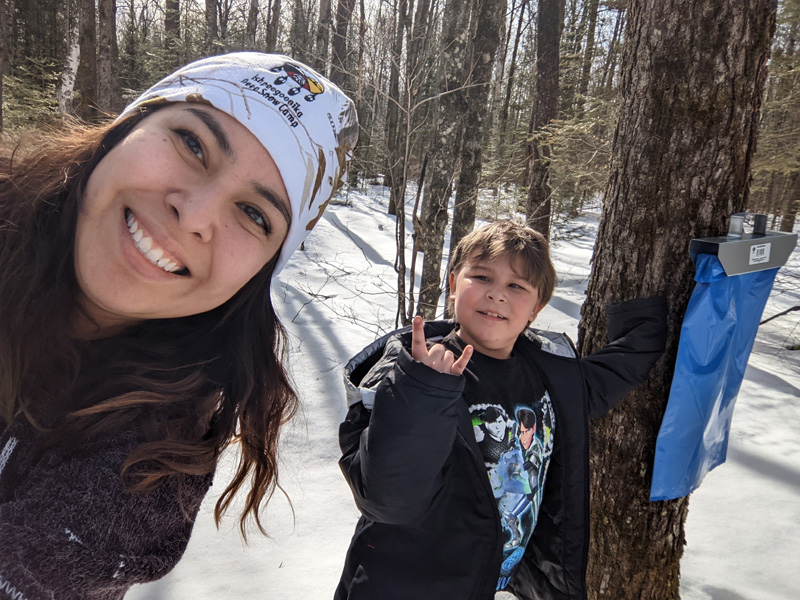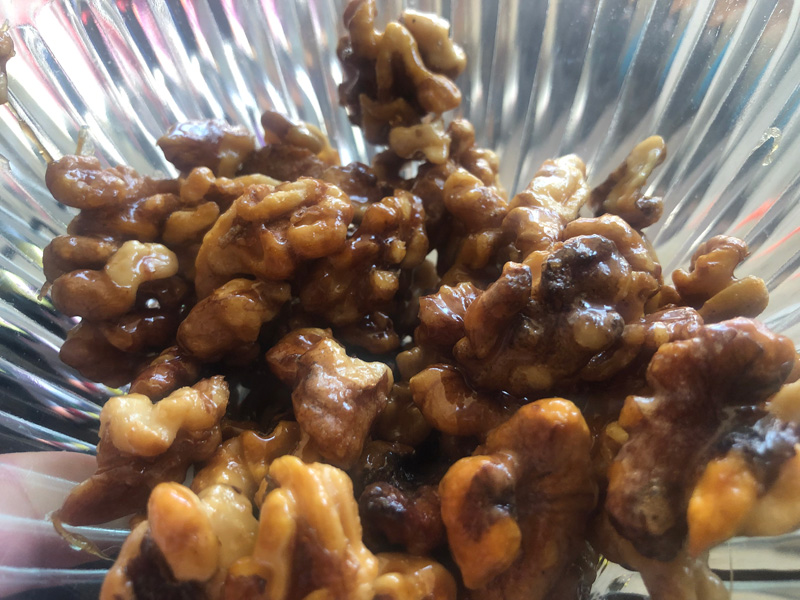PHOTOS COURTESY OF CASSANDRA GRAIKOWSKI
This story originally appeared in the Heavy Table’s Tap newsletter for Friday, March 31, 2023. To subscribe to the Heavy Table’s three bi-weekly newsletters, back us on Patreon.
MOLE LAKE RESERVATION, WISCONSIN – Iskigamizige-giizis, the Maple Sugaring Moon, is the Ojibwe lunar month situated around April. Iskigamizigewin, the process of harvesting and boiling down maple sap, is integral to the Ojibwe food harvesting cycle. Gifts from Aninaatig, the Maple, are sacred foods. We give ziinzibaakwad, maple sugar, and zhiiwaagamizigan, maple syrup, at ceremonies and to elders from whom we are asking teachings. And although they’re nice on pancakes, to us, neither is considered solely a “breakfast food.”

I love the look of joy and excitement that comes to elders’ eyes when I ask them about having been children at the iskigamizigan, sugar bush. They talk about having spent two or more weeks out there, gathering sap, roasting meat over a fire, and eating sweet maple taffy and sugar cakes. Throughout the 19th and 20th centuries, fewer and fewer children had that experience. Forced assimilation, land loss, unrecognized treaty rights, the destruction of maple groves, and large-scale commercial sugar bushes all contributed to a decline in Ojibwe people producing maple syrup and sugar. There are now revitalization programs in various communities aimed at bringing children back to the iskigamizigan. Cassandra Graikowski, Mole Lake’s Cultural Activities Coordinator, runs one such program. I am working with her on the language portion.
Saka’aaganing, also called Mole Lake, is named for the headlamps (once torches) worn while spearing fish. Graikowski and her team at Saka’aaganing are reclaiming and revitalizing Ojibwe language and cultural traditions, including iskigamizigewin. At approximately 4 square miles, 0.5 square miles of which is water, the Mole Lake Reservation, located on Wisconsin State Highway 55, is small, and, quite honestly, I was surprised to hear they had enough land to support their community and a grove of Aninaatigoog (maple trees). It turns out that one of their community members has a grove in her backyard, and that grove is now the focus of their iskigamizigewin revitalization efforts.
SANDS IN AN HOURGLASS
Graikowski compares cultural revitalization to an hourglass: “We used to have this wealth of knowledge and then as the boarding schools came along and assimilation happened, the knowledge got smaller until there were just a few trickles of sand coming through the center. I really hope we are on the edge of standing back out on that hourglass of knowledge, and slowly getting back to where we were, but that little trickle of knowledge is the scariest part.”

The loss of elders, says Graikowski, means that time is of the essence when it comes to restoring traditions. “The scarier part of revitalization,” she adds, “is making sure you’re spending your time wisely and connecting to the right people and making sure you’re not asking too much from some people because there’s a lot to learn and so little time.”
Last season, when Graikowski’s team hosted their first Iskigamizigewin camp, participants were able to put out 60 taps, collect over 100 gallons of sap, and produce 36 pints of syrup. To spark community interest in coming out to learn about Iskigamizigewin, they started off with a huge pancake breakfast. Having not yet tapped one tree, they did not have their own syrup, but they were able to purchase some. Their pancake plan was a success. The community came out to enjoy the feast, and, afterwards, the kids, and some adults, went out to tap trees. At this year’s pancake breakfast kick-off, they were able to top pancakes with syrup they harvested and processed themselves! It has been a long time, but children and adults at Saka’aaganing are coming back to the iskigamizigan.
When I asked Graikowski how readers could best support Mole Lake’s language and culture revitalization efforts, she said, “if they feel like dropping in and saying ‘Hi’, that’s totally more than welcome… It’s an honor, for them to appreciate our culture and come and visit, but on top of that I think it’s mutually beneficial to learn about each other and understand each other a little bit more because then we take down those walls that divide us.” She encourages readers who want to join their language and cultural revitalization activities to email her at: cultural.activities@scc-nsn.gov
MAPLE COATED NUTS

This recipe comes from David and Patra Wise, from Native Wise LLC, a Native owned business that sells maple products. I experimented with it and added the following portions of ingredients. Although we are unable to help readers reproduce the exact smells of the sugar bush in their kitchens, preparing this recipe comes close. About 5 minutes into baking this treat, I could smell that familiar smell of sap boiling.
1 cup nuts (The Wise recipe calls for halved pecans; walnuts, pictured, also work. I used unsalted, shelled peanuts because of a family tree-nut allergy)
¼ cup maple syrup
1-2 pinches sea salt
Put nuts in a bowl and pour the syrup over them. Toss them so that each one is coated with syrup. (If you find you have syrup pooling in the bottom of your bowl, you need more nuts.)
Sprinkle on the sea salt and toss them again until everyone is nicely coated. Put parchment paper on a cookie sheet, spread the nuts on the sheet, and bake in the oven at 375 F for 14-15 minutes (10-11 minutes for peanuts). Cool and serve. (Do not let them completely cool on the parchment or they will be very difficult to remove.) Store in a glass container once cooled.
Serving Suggestions: Eat as is or try mixing them with dried cranberries. They also make a great salad topping.
Additional Notes: You really need to use parchment paper with this recipe. I tried using wax paper, and ended up having to scrape it off my cookie sheet. You don’t want the nuts to sit in a pool of syrup on the parchment paper because that makes a really sticky mess and can cause the nuts to burn. When you can smell syrup cooking, the nuts are just about done, so watch them carefully at that time. If you want them to taste sweeter, coat them with more salt.
Want to buy Native Wise Foods products? Shoppers can purchase some products online through Native Wise LLC (https://nativewisellc.net/) and through AICHO (http://www.aicho.org/indigenous-first-art–gift-shop.html#/).
MAPLE TEA
For those of us unable to get to the Iskigamizigan or for times when the sap is not running, this recipe replicates the experience of tasting and smelling the sweet boiling sap as it cooks over the fire, and the experience of using a little of the boiling sap to make tea.
Black tea: 1 bag per mug OR 2 bags per pot
Maple sugar: 1 teaspoon per 11oz mug OR
Maple syrup: 1 tablespoon per 11oz mug
Boiling water
Boil the desired amount of water in an electric kettle or on the stove. Do not heat it up in the microwave, as the water will not reach a suitable temperature for making tea, and you will not get the full taste of this beverage. If you can boil the water over a fire, that will add even more smoky taste to the drink.
Once the water reaches a hard boil, let it sit for 2 minutes and then pour it over the black tea bag(s). Let the tea steep for 3-5 minutes for a mug or 7-10 minutes for a pot (depending on how strong you want your tea).
Remove the bag(s) when tea has reached the desired strength, stir in the maple sugar or syrup, and drink the tea. (if you used a tea pot, add the maple sugar or syrup to your cup, not the pot).
If you want the sweet maple taste to be stronger than the tea taste, leave the bag in for a shorter amount of time and/or double up on your sugar or syrup. You can also add a little milk to the tea to have an even more amazing beverage.

